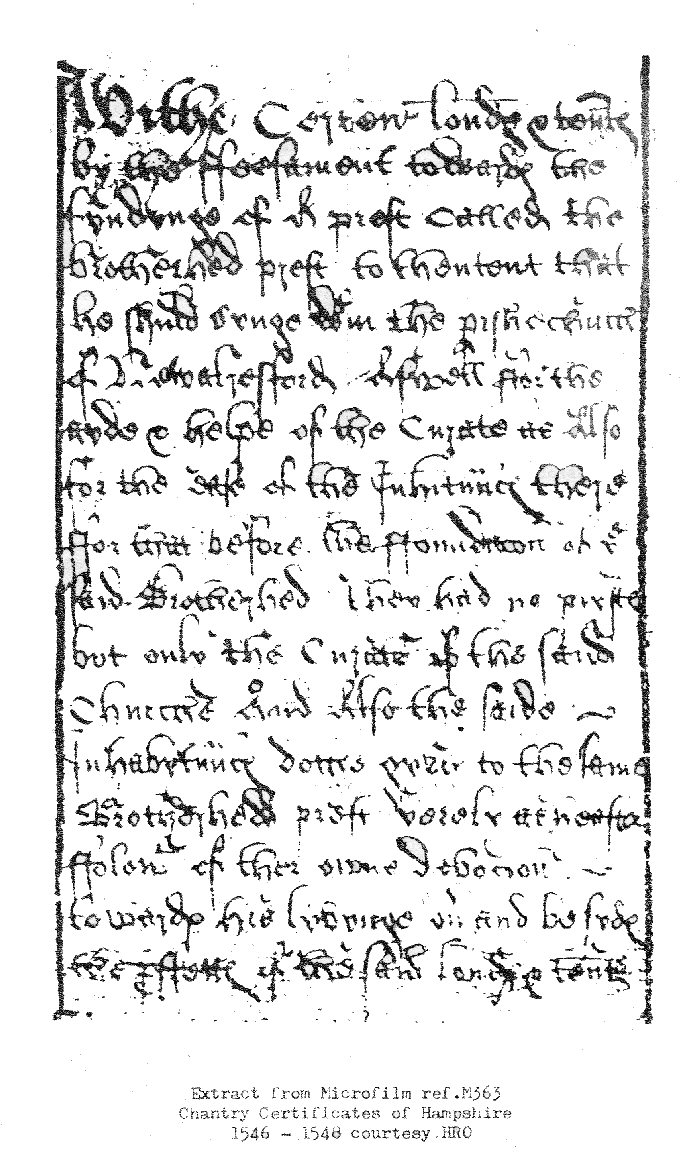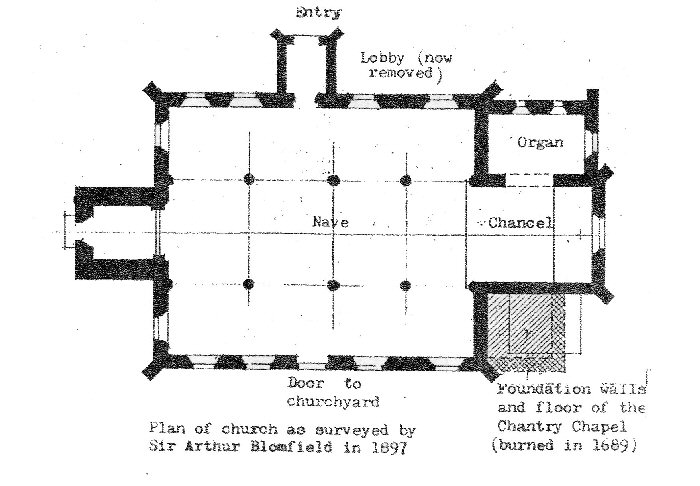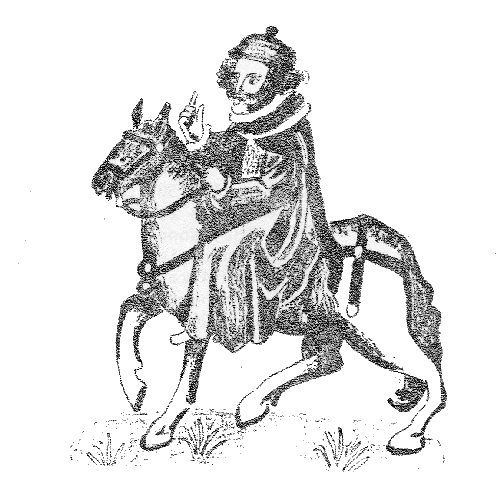NO. 73 THE ALRESFORD CHANTRY
by Raymond Elliot
Geoffrey Chaucer, writing in the late fourteenth century, confirms that a popular form of religious endowment, at that time, was the creation of a chantry in conjunction with the local parish church. Here prayers and chants would be offered for the donor's soul in perpetuity in return for the promotion of continuing charitable work. This encouraged the establishment of almshouses, colleges, grammar or free schools, hospitals and the like together with a chantry priest to offer the prayers In support. Close relationship between church and the parishioners at that time enabled brotherhoods or guilds or fraternities to be formed, and with pious persons to donate lands and properties as well as monies to finance the chantries, and so ensure the future welfare of their souls. Chaucer also reflects that the Easter offering at church was always for the benefit of the priest, the traditional amount being two pence from each worshipper.
A chantry would include a provision for the priest to sing mass daily for the repose of the souls and/or provide also for the education of poor children, the chantry priest being required to act as the schoolmaster. The sweeping away of many of these 'chantry' schools was one of the crimes which attended the English Reformation in the mid sixteenth century.
The Alresford Chantry was 'situate created and founded within the parish church of St. John the Baptist at New Alresford. It would have been founded during the later part of the fourteenth century and was known as the 'Brotherhood or Fraternity of John or Jesus'. Being a daughter church in the benefice of the Liberty of Alresford and thus under the jurisdiction of the rector of St. Mary's Church at Old Alresford, the church of St. John was served by a curate only. In 1546 the Chantry was described as :
'One Brotherhood or Fraternity there endowed with certain lands and tenements by the feoffment towards the founding of a priest called the Brotherhood priest to the intent that he should sing within the parish church of New Alresford as well as for the aid and help of the curate as also for the ease of the inhabitants there for before the founding of the Brotherhood they had no priest but only a curate of the said church and also the said inhabitants do give to the same Brother hood priest yearly at Easter following of devotions towards his living and besides the profits of the said lands and tenements'.
Foundations and the tiled floor of a small chapel were uncovered at the south east corner of the old parish church during the reconstruction of the church by Sir Arthur Blomfield in the years 1897 - 8. It is reasonable to say that this floor and the foundations would have been the remains of the Chantry Chapel built for the Brotherhood or Fraternity of John; but it was burnt down in the Great Fire of 1689. The area is today occupied by the Organ Vestry.

The Alresford Chantry of the Brotherhood or Fraternity of John grew and prospered over the years until by 1550 it had a yearly value of £3.14s, of which the priest received £2.10,8d. It was endowed with a tenement on the east side of the Market Place - now Broad Street - and known as Jesus House, together with a shop and tenement next to the passageway leading to the north entrance to the church, i.e.East Street. The endowed lands had multiplied over the years and amounted to sixteen strips of arable land, making a total of six and a half acres, in various furlongs spread throughout the common fields on the south and west slopes of New Alresford.
King Henry's legislation for the dissolution of the chantries was planned in 1545, to follow the seizure of the monasteries, but postponed due to his death. On coming to the throne Edward VI re established the Act, which confirmed that all chantries at any time in the previous five years - including that at New Alresford church - were declared to belong to the crown, together with all lands and revenues associated with them; and all such confiscated properties were to be placed under the control of the Court of Augmentations. This royal decree caused over one thousand chantries, throughout; the country, to be suppressed by Henry and Edward. Early in 1551, during the bishopric of Bishop Gardiner, the chantry of the Brotherhood of John at Alresford Church, together with its endowment, lands and tenements, was duly confiscated and became Crown property. This is confirmed by the 'Survey of Alresford' completed in the following year.

By the mid-sixteenth century Alresford had been part of the Bishopric of Winchester's estates for nearly nine hundred years. Early in the reign of Edward VI (1547-1553) however Bishop Stephen Gardiner of Winchester was dismissed. Before his successor Bishop Poynet, could accept the appointment of the see however, the King ordered 'great alienations of much of the extensive lands and revenues anciently belonging to the bishopric' and the bishop to 'receive in return a fixed income of two thousand marks a year, chiefly derived from the impropriated rectories. One of the properties seized by the King, under this royal decree, was the Bailiwick of Sutton, which at that time included the town of New Alresford. And so the whole of the lands and dwellings of New Alresford town became Crown property.
The King now sought to make further rewards to persons who had so successfully carried out the confiscation of monasteries and chantries. So in May 1551 on receiving the bishopric lands from John Poynet, the King then 'gratified his servants with lands and manors of the bishopric'. By this legislation he granted the manor of Sutton (which included the Town of New Alresford) to Sir John Gates, a member of his Privy Council. Gates dispatched his surveyor, Anthony Browne, to the Bailiwick of Sutton to make a comprehensive survey and report back.

Born about the year 1504, Sir John Gates' career in the royal court had begun in 1535, when Henry made him a gentleman of the Privy Chamber. He became an active commissioner carrying out many royal tasks with much success, for which he was amply rewarded with positions and properties. At the coronation of Edward, in 1547, Gates was created a Knight of the Bath, and in 1551 the King raised him to he Vice Chancellor of his Privy Council. He had been a very active commissioner in the sale of many chantry lands for which he was further rewarded with appointment as Chancellor of the Duchy of Lancaster.
On the death of King Edward in August 1553, and the succession of Mary, John Poynet was deprived of the bishopric of Winchester and fled to the continent where he died in 1556. Stephen Gardiner was immediately restored to the see of Winchester and led the welcome to the succession of Mary on her return to England and her entry into London. Sir John Gates however supported the Duke of Northumberland in promoting the celebrated 'devise' of succession in favour of the Lady Jane Grey, and had joined the unsuccessful plot against the new Queen Mary. For this act of treason Gates was arrested and tried before a special commission, pleaded guilty and was executed three days later. His many possessions were forfeit to the crown, including his short lived ownership of the Bailiwick of Sutton; and so the Town of New Alresford again became royal property,
In July of the following year Mary married Philip of Spain, the ceremony being performed in Winchester Cathedral by Bishop Gardiner. And in 1554, under Mary's direction an Act was passed 'repealing all statutes made against the see apostolic of Rome since the 20th year of King Henry VIII.' By 1557 the episcopal property seized from Bishop Poynet by King Edward was restored back to the seat of Winchester - including the manor of Sutton together with the township of Alresford.
The seized chantry lands and properties of the Brotherhood of John however were not restored, for these were to remain Crown property for many years to come. In 1589 Queen Elizabeth authorized the sale of the late Brotherhood lands to Richard Braithwaite and Roger Bramley, both of London. They soon sold the properties, and by the mid seventeenth century the ownership of these particular lands returned to farming families in New Alresford. The remaining seized chantry lands continued as Crown property until 1618 when James I sold them to James Outerlong and Richard Gurnard of London, these again eventually returned to local ownership. Jesus House and the other tenements were destroyed in the Great Fire of Alresford in 1689, but the site of Jesus House is recorded as the property and residence of James Apsdale in 1774. The site is now occupied by the supermarket.
Copyright Raymond Elliott August 1991
Sources - Chantry Certificates of Hampshire 1546 - 1548 HRO M363Sir Arthur Blomfield - Plan of church in 1897
Survey of Alresford 1552 - HRO Eccles 136/1
S.H. Casson - Bishops of Winchester - HCL
Victoria County History of Hampshire - HCL
Dictionary of National Biography - HCL
Tudor Constitution - G,R, Elton
Survey of New Alresford 45M83 HRO
Alresford Displayed No, 4 - Working Party
